Potala Palace - Symbolic Architecture of Tibet
Potala Palace, regarded as landmark and the symbol of Tibet, is a great giant palace consisting of many houses, towers, chapels, etc. According to the Guinness Book of World Records, Potala Palace is the highest (in altitude) palace in the world. Because of its spectacular architecture style, it is honored as one of the most beautiful architectural buildings in the world. As the historic ensemble of Lhasa, Potala Palace, together with the exceptional Jokhang Temple and Norbulingka is the UNESCO World Heritage Site.
The main buildings of Potala Palace are situated on the Red Hill by the side of Lhasa River. It is not only a splendid palace, but also a treasure house where you can see precious arts and learn Tibetan culture and history. Because of its brilliant arts and history, travelers see it as the No. 1 must-see attraction in Tibet. By climbing the steps up to the top, you can see the great views of Lhasa city as well as beautiful plateau landscape far away.
Potala Palace Facts
- Rating:
- Season:
- April to October
- Type:
- World Heritage Site, Architecture, Religious Site
- Altitude:
- 3700 meters
- Location:
- Moburi Mountain in the northern Lhasa
Potala Palace History
Potala Palace’s history can be traced back to about 1,300 years ago and it has been through several large reconstructions ever since. It was originally built in the 7th century when the Tubo Kingdom ruled Tibet to house the King Srongtsen Gampo and his two wives - Princess Wencheng of Tang Empire and Princess Bhrikuti of Nepal.
After the fall of Tubo Kingdom, Potala Palace was almost ruined by constant wars. Then in the 17th century, it came the most important reconstruction in Potala’s history. His Holiness - the Fifth Dalai Lama decided to rebuild Potala Palace. He received helpful hands from Qing Empire. The constructions took many years. At last, the Fifth Dalai Lama moved the government from Drepung Monastery to Potala, which made Potala the political and Buddhism center of Tibet. Since the Fifth Dalai Lama, several small reconstructions had been conducted by the later Dalai Lamas. The main body of Potala Palace has remained as the same as the past.

Amazing Architecture of Potala Palace
Potala Palace Highlights
As the symbol of Tibet, Potala Palace has many things worth seeing, the architecture of the entire construction, the splendid well-preserved artworks and various kinds of religious treasures and etc. By sightseeing all those highlights, you can trace back to the old days of Tibet and experience the glory of Tibet history.
Tibetan Architecture
Potala Palace is one of the most brilliant architectural buildings standing on the precipitous hill. Having a majestic exterior of 13 storeys in the total height of 117 meters, the whole palace was built by wood and stones. The walls were piled by granite with a thickness of 2-5 meters. The roof and eaves are made of woods with beautiful carvings about Buddhism. Constructed by the white and red palaces, there are ornate chapels, halls, rooms inside. The palace can be divided into two main parts: the White Palace around and the Red Palace in the center. The White Palace was the living quarters of the Dalai Lama and the office to deal with political and Buddhist affairs. And the Red Palace has a complicated layout consisting of different Buddhist halls, chapels and libraries.
Splendid Artworks
Inside the majestic Palace is the treassure house of splendid artworks. Apart from being the artistic concentrate of ancient Tibet architecture, Potala Palace is also an art treasure of Tibet. The most outstanding representative is the 698 murals on the walls and along the corridors which describe some important events happened in Tibetan history, like the marriage alliance of Princess Wencheng and Srongtsen Gampo, and lifetime stories of famous Buddhist masters such as the 5th Dalai Lama. Besides the murals, you can also find a large quantity of exquisite Thangkas, a typical religious scroll painting made on silk, cloth or paper and framed by color satin, which mainly tell the historical events, religious figures and Buddhist doctrines. There are also many kinds of crafts to present the Tibetan local life.
Religious Treasures
Potala Palace is one of the holiest buildings of Tibetan Buddhism. It is the palace of the leader of Tibetan Buddhism – Dalai Lama. In ancient times, Potala Palace opened a Buddhist school to teach Buddhism. It houses many stupas of past Dalai Lamas. And in both Red Palace and White Palace, there are lots of precious statues, especially the 2 meters high statue of Tsong Khapa (in East Chapel), a silver statue of Padmasambhava (in South Chapel), and statues of Sakyamuni, Dalai Lamas and Medicine Bduddha (in North Chapel). Integrated into different Buddhist art of Han dynasty, India and Nepal, the sculptures is another precious treasure in the palace.
 Exquisite Murals Shown in Potala Palace
Exquisite Murals Shown in Potala Palace
 Sacred Buddha Hall
Sacred Buddha Hall
 Holy Stupas in Potala Palace
Holy Stupas in Potala Palace
How to Get to Potala Palace
Located in the northern part of Lhasa, adjacent to Jokhang Temple with 1.6 km and 1.5 km away from Barkhor Street, Potala Palace is mostly chosen as the first attraction of a Tibet travel, and you can easily get there from the airport or train station in Lhasa.
● 60 km (70 min by car) away from Lhasa Gonggar Airport
● 9 km (30 min by car) away from Lhasa Railway Station
By connecting many domestic cities including Beijing, Shanghai, Chengdu, Chongqing, Xian, Guangzhou and more, taking flight to Lhasa Gonggar Airport is the first choice to arrive in Lhasa. With a distance of 60 km from airport to Potala Palace, you can take the airport shuttle bus to get there in 1-1.5 hours. Besides the airline, you can take the Qinghai-Lhasa Railway to Lhasa Railway Station and take a taxi to the Palace. If you book Tibet tour with us, we can arrange the private transfer service and pick you up at the airport or train station.
★ Useful Links: Flights to Tibet | Trains to Tibet
Best Place to Photograph Potala Palace
As we learn, Potala Place is an extremely outstanding attraction with spectacular architectures. It attracts numerous shutter-bugs to admire its charm and take wonderful pictures. There are three recommended places to take beautiful pictures of Potala Palace.
Chakpori Hill
Chakpori Hill, also called Yaowang Mountain, is a sacred hill located over the street of Potala Palace. On the cliff of Chakpori Hill, you can find many well-preserved figures of Buddha which may date back to 1,000 years ago. It is the best place to take a full view of Potala Palace and shot the Potala Palace under sunrise or sunset. It is suggested to get up early to get the best spot there because a large crowd of photographers will go there to shot Potala Palace bathed in the first rays of the sun.
Zongjiao Lukang Park
Zongjiao Lukang Park is located behind the Potala Palace. Local people regard it as the best resort to take a leisure walk because it has comfortable environment with bridges, lakes, birds, fishes as well as green trees and various flowers. Local Tibetans will come here to do morning exercises or just hang out with families and friends. Here you can take the best picture of the inverted reflection of Potala Palace from Dragon King Pool.
Potala Palace Square
In the square in front of Potala Palace, you can take a full view of Potala Palace. In the morning, you could also take the picture of the local Tibetans who are taking kora around Potala Palace. If you visit at night, you can stand at the square palace to take a sparkling night scene of Potala Palace.
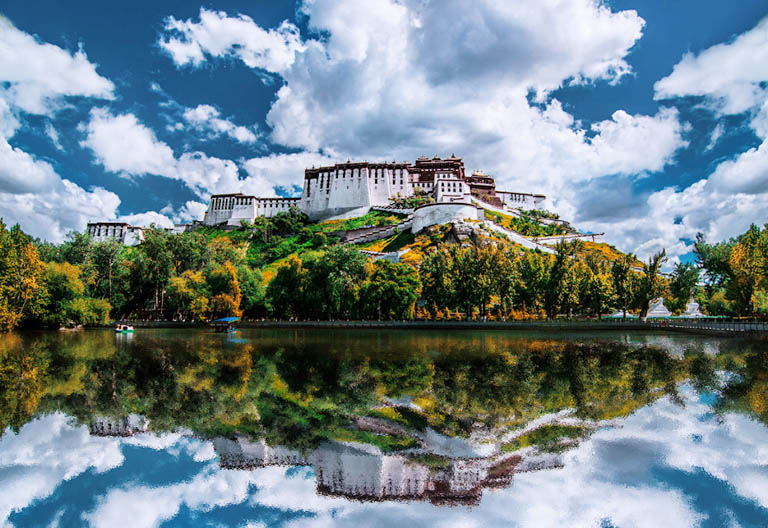 Potala Palace with Impressive Reflection (shot from Zongjiao Lukang Park)
Potala Palace with Impressive Reflection (shot from Zongjiao Lukang Park)
 People Kora around Potala Palace (Shot from Potala Palace Square)
People Kora around Potala Palace (Shot from Potala Palace Square)
Useful Travel Tips of Potala Palace
Best Time to Visit Palace
Usually, it is available to visit Potala Palace in all seasons because the trip is not much influenced by weather. But remember to take an overcoat even in summer days while visiting Potala Palace because Lhasa has a sharp temperature difference in the day and night. If you want to extend your Lhasa tour to other areas like Namtso or Everest, May ~ October is the best time.
Limited Tickets & Restricted Visiting Time
With the ticket of 200 RMB (May–October) or 100 RMB (November–April), Potala Palace allows less than 2,300 tourists and pilgrims to enter during 9:00-16:00 of each day, excepting for holidays & big event. The ticket should be booked one day beforehand and there is only one hour for visiting the inner part of Potala Palace, so you’d better figure out what you want to see most and arrange your time properly. There are about 30 sites along the relatively fixed visit route and some of them can’t be missed out such as the Stupa of fifth Dalai Lama, Dharma Cave and Saint Kwun Yum Hall.
Manners & Taboos
Since Potala Palace is an important Buddhist site, tourists need to dress and act respectfully. Please do not point your fingers at the statues and remember to take off your sunglasses or hat while visiting the halls. Water and lighters are forbidden to be taken to the palace, but there is water for sale in the White Palace Square. It is also not allowed to take photos after entering the palace.
Be Ready for Lots of Steps
Sitting at 3700 meters above the sea level, you need to climb up from the South Gate to the top of the Potala Palace which covers over 1,000 steps. The climbing time does not count in your “1 hour” limit. Along the climb way, make sure to stop and rest a while.
 Magnificent Polata Palace (Shot from Chakpori Hill)
Magnificent Polata Palace (Shot from Chakpori Hill)
 The Steps Leading to White Palace
The Steps Leading to White Palace
 Beautiful Nightview of Potala Palace
Beautiful Nightview of Potala Palace
Nearby Attractions Around Potala Palace
Jokhang Temple: Jokhang Temple (or Jokhang Monastery) is the spiritual center of Tibet and the holiest destination for all Tibetan pilgrims. Situated at the heart of the old town of Lhasa and surrounded by Barkhor Street, this 4 storied building, was built in the 7th century by Songtsan Gambo, with gilded bronze tiles covering the roof, and demonstrates a combination of the architectural style of Han, Tibetan, India, and Nepal, as well as a Mandala world outlook of Buddhism.
Barkhor Street: Barkhor Street is the popular circumambulation for pilgrims and a commercial center. Being “a saint road” in the eyes of Tibetan, you can feel the local spiritual belief when you see different pilgrims from all over Tibet in different dresses and dialects to pray devoutly along Barkhor Street. Like a miniature of Lhasa, it shows you another aspect of the Tibetan life. There are an eyeful of fantastic stores and shops to display most characteristic items and commodities such as thangkas, prayer wheels, prayer flags and milk tea. Barkhor Street is such a great place to buy some souvenirs and suck up the local Tibetan lifestyle.
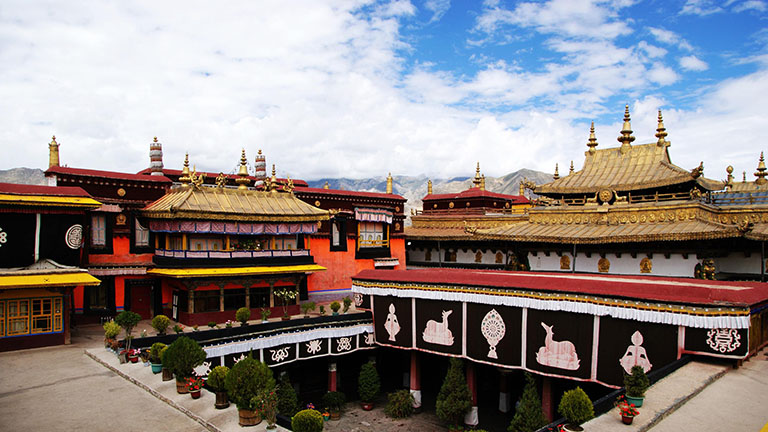 Jokhang Temple
Jokhang Temple
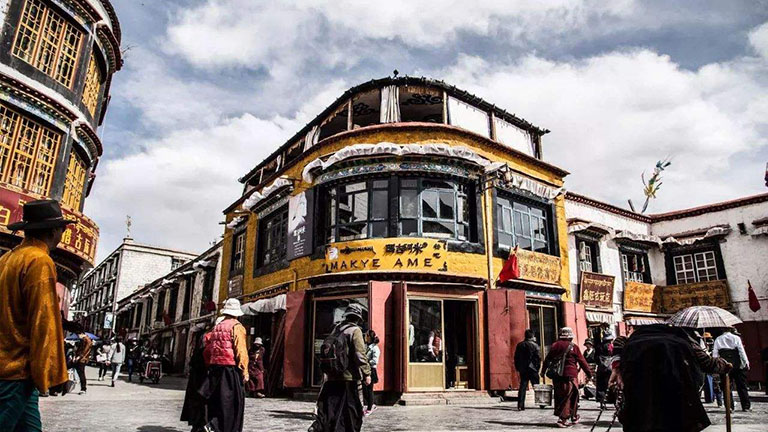 Barkhor Street
Barkhor Street
How to Plan A Tibet Tour
Tibet is too vast to be visited in one single trip, but planning ahead of time can make most of your holiday. A classic Tibet tour always takes about 4 ~ 8 days. Apart from 2 days for arrival and departure, it usually needs 2 other days to explore majestic Potala Palace and other landmarks in Lhasa, the capital of Tibet. With a day trip’s distance from Lhasa, Namtso Lake is another perfect tour extension if you visit Tibet from May to October.
☛ 4 Days Holy City Lhasa Private Tour - Heart of Tibet
☛ 5 Days Lhasa City and Holy Lake Namtso Tour
To explore further, it’s strongly recommended to travel from Lhasa to Mount Everest via Gyantse and Shigatse, which usually needs 4 more days. It is an unforgettable sightseeing trip with lots of attractions to visit, such as Yamdrok Lake, Karola Glacier, Kumbum Stupa of Palcho Monastery, Tashilhunpo Monastery, etc. Of course, the biggest draw must be gazing upon the unparalleled north face of the world’s highest peak – Mount Everest.
☛ 6 Days Lhasa Gyantse Shigatse Historical Tour
☛ 8 Days Everest Base Camp Tour - Top of the World
☛ 9 Days Tibet Discovery Tour plus Everest and Namtso Expedition
For Buddhist followers and hiking lovers, you are suggested to travel to Ngari to join the kora around the holy Mt. Kailash and sacred Lake Manasarovar, which usually takes about 5 ~ 8 more days from Lhasa. The wild nature of Ngari is spectacular as well.
☛ 13 Days Mt. Kailash & Lake Manasarovar Trekking Tour
☛ 16 Days Mt.Kailash Pilgrimage Private Tour
If you have your own needs or interest, just feel free to contact us to customize a trip of your own!
 Lhasa, Namtso, Mount Everest and Ngari are four most popular destinations in Tibet
Lhasa, Namtso, Mount Everest and Ngari are four most popular destinations in Tibet
Lhasa Top Attractions
Lhasa Travel
Recommended Tour Packages
Escorted by a skilled private drivers and accompanied by a professional local tour guide to organize all the activities, all you have to do is to enjoy your fantastic Tibet journey. Time can never be wasted waiting for a group, hopping on and off buses or negotiating unfamiliar destinations.
-

Lhasa
4 Days Lhasa City Private Tour - Heart of Tibet
Highlights: Potala Palace, Barkhor Street, Sera Monastery
$475 / Details -

Lhasa / Gyantse / Shigatse / Everest / Lhasa
8 Days Lhasa to Mount Everest Private Tour
Highlights: Potala Palace, Yamdrok Lake, Tashilhunpo Monastery, Mt. Everest
$1,324 / Details -

Lhasa / Gyantse / Shigatse / Mount Everest / Gyirong
7 Days Lhasa to Gyirong Overland Tour via Mount Everest
Highlights: Potala Palace, Yamdrok Lake, Palcho Monastery, Mount Everest
$1,058 / Details
Have a question? Get answers from our travel experts soon!
- Your Question:
- Your Name:
- Your Email:
- Submit
Questions & Discussions
Following are latest questions and answers from our webusers and customers. You can learn many useful information from the discussion and cases. You can also join in the discussions or ask your own question. Our experts will help you ASAP.
Thanks for your message. This page is written by Louis at Tibet Discovery. It was published on 25-06-2010.
Thanks for your question. As you know, the Potala Palace is world famous for its outstanding layout, construction, craftwork, painting and sculpture. I think there are many different elements attracting different people to Potala Palace. For its feature of architecture, there is a short comment as your reference.
Firstly, Potala Palace is located on the mountain. It makes full use of the hilly topography to create both the majesty and the harmonious integrity –an unparalleled altitude in terms of architectural aesthetics achievement.
Then, Potala Palace is an infrequent building integrate perfectly the style of Tibetan Buddhist monastery and palace. It remains its original appearance despite that some buildings experienced several reconstruction.
At last, the decorative art of the Potala Palace is embodied in the design of each part, including granite walls, roofs with copper tiles, windows for ventilating and overlooking, dharani pillars, etc..
To see is to believe. Welcome to Tibet and explore this distinguished architecture by yourself.
Thanks for your question. The Potala Palace was originally built in the 7th century by Srongtsen Gampo, the king of Tubo, as palace for him and his two wives - Princess Bhrikuti of Nepal and Princess Wencheng of Tang Empire. After the fall of Tubo Kingdom, Potala Palace was almost ruined by constant wars until 17th century when came the most important reconstruction during Potala’s history. His Holiness - the Fifth Dalai Lama decided to rebuild Potala Palace. The constructions took almost many years. At last, the Fifth Dalai Lama moved the government from Drepung Monastery to Potala, which made Potala as the political and Buddhism center of Tibet. Since the Fifth Dalai Lama, several small reconstructions had been conducted by the later Dalai Lamas. The main body of Potala Palace has remained as the same as the past.

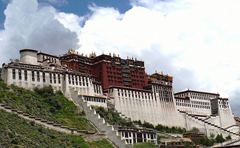

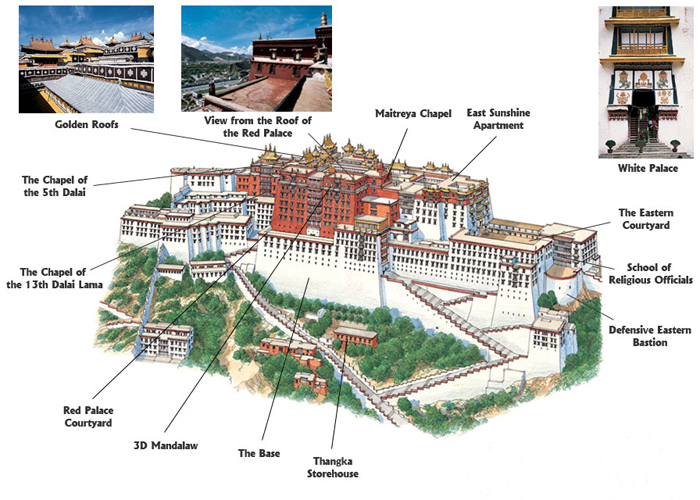
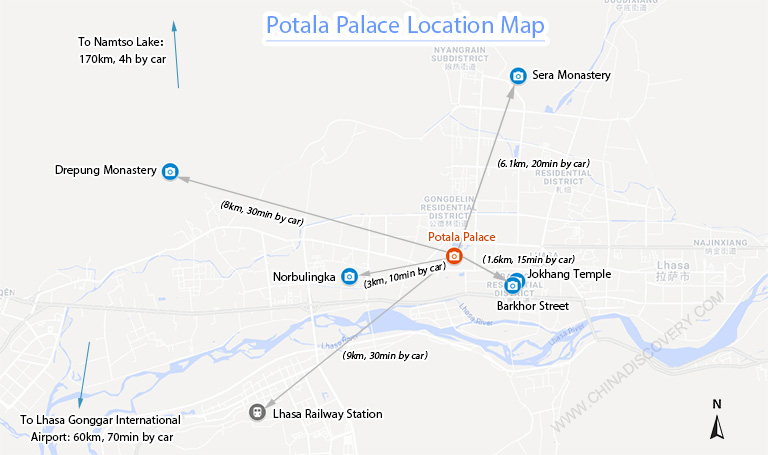
 Karen
Karen Wonder
Wonder Jack
Jack Rita
Rita Johnson
Johnson Vivien
Vivien Wing
Wing Ariel
Ariel Leo
Leo Tracy
Tracy Evelyn
Evelyn April
April Phoebe
Phoebe Samantha
Samantha Amber
Amber Felix
Felix Sean
Sean
